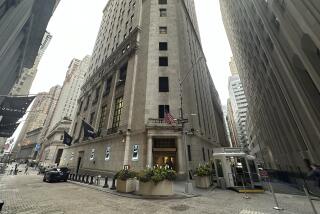Jobless Rate Held to 4.3%, Lowest in a Generation
WASHINGTON â The nationâs business expansion produced nearly 300,000 new jobs in May, enough to hold the unemployment rate at a surprising 4.3%, the lowest level in a generation, the Labor Department reported Friday.
The news of a surge in jobs helped power a strong stock market rally, with the Dow Jones industrial average gaining 167.15 points to close the day at 9,037.71. The index of blue chip companies closed above the 9,000 level for the first time in two weeks.
Many economists had believed that the 4.3% jobless level reached in April was a fluke and that a business slowdown would soon drive the rate higher.
Instead, the expansion continued, even in the face of Asiaâs economic problems. Economic activity in the current quarter âmight exceed my expectations and everyone elseâs,â said Lyle E. Gramley, chief economist for the Mortgage Bankers Assn. of America and a former member of the Federal Reserve Board.
The jobless rate is at its lowest level since 1970, and inflation seems well under control.
The only discouraging note in Fridayâs report was in the manufacturing sector, where jobs dropped by 26,000.
âIt is reasonable to suspect that at least some of the recent declines in manufacturing employment and hours are related to Asiaâs economic problems but we have no way of quantifying their impact,â Katharine G. Abraham, Commissioner of the Bureau of Labor Statistics, told a hearing of Congressâ Joint Economic Committee.
However, the dip in manufacturing was overshadowed by a robust performance in the service sector of the economy. Retail stores and shops, computer and data services companies and temporary help firms all reported strong gains in employment. Overall, businesses added 292,000 workers to their payrolls in May, more than expected. The gain in April was 302,000, revised upward from the first report of 262,000.
Wages are rising, a response to the tightening labor markets. Average hourly earnings increased 4 cents in May, following a gain of 6 cents in April. The average wage has climbed 4.3% over the same month a year ago. Wages are climbing faster than prices--the Consumer Price Index has risen 1.4% during the last 12 months.
âWorkers are really just recovering losses in wages suffered in the first five years of this decade,â said Tom Palley, an economist for the AFL-CIO. Workersâ purchasing power is climbing back to the level of 1989, he said.
The length of the average workweek is rising too, another sign of strength in the economy. The average workweek rose to 34.7 hours, edging up from 34.5 hours. In factories, the average workweek was 41.7 hours, up from 41.4. Higher pay and more hours on the job increase workersâ spending power and keep the demand side of the economy humming, Palley said.
âWage growth is reasonable and sustainable,â he said. The Federal Reserve Board âshould hold steady--no change in policy is warranted.â
Housing is booming because of low interest rates. âThis is a great economy for the housing industry,â said Jason Altman, senior economist at the National Assn. of Realtors.
âWeâre thinking that the Fed is going to stay putâ on interest rates, he said.
While the AFL-CIO and real estate agents are happy with a stand-pat policy, others still fear a resurgence of inflation and want the Federal Reserve to be vigilant against rising prices.
âThe Fed is on the horns of a dilemma,â said Gramley of the Mortgage Bankers Assn. âThe domestic economy really needs some restraint. But the Fed canât afford to tighten monetary policy given the international situation.â
Gramley argued that the economy is in danger of overheating and causing a burst of inflation unless the Federal Reserve moves to raise interest rates. However, money already is flowing out of Asian nations and into the U.S. economy because of the unsettled economic situations in South Korea, Thailand and Indonesia. If interest rates were to be raised, even more capital would be attracted from Asia, making it harder for those countries to recover their economic health.
Fearful of making things worse abroad, the Federal Reserve will âsit still as long as possible,â Gramley predicted.
Gary Schlossberg, an economist at Wells Fargo, said that he thinks the Fed will sit on the sidelines, watching without reacting. âIt is a high-stakes gamble,â he said.
U.S. consumer spending âremains stronger than we would have thought,â he said. But the slowdown in Asia could eventually slow the business expansion in the United States, he noted. Because their currencies are depressed relative to the dollar, the Asian nations will be buying less from the United States.
More to Read
Inside the business of entertainment
The Wide Shot brings you news, analysis and insights on everything from streaming wars to production â and what it all means for the future.
You may occasionally receive promotional content from the Los Angeles Times.










